Torana of the Main Shrine at Yetakha Baha
Kathmandu, Nepal 10th–11th centuryTorana of the Main Shrine of Yetakha Baha; Kathmandu, Nepal; 10–11th century; wood; total width approx. 8 ft. 5 in. (2.57 m); photograph by Sameer Tuladhar, 2021
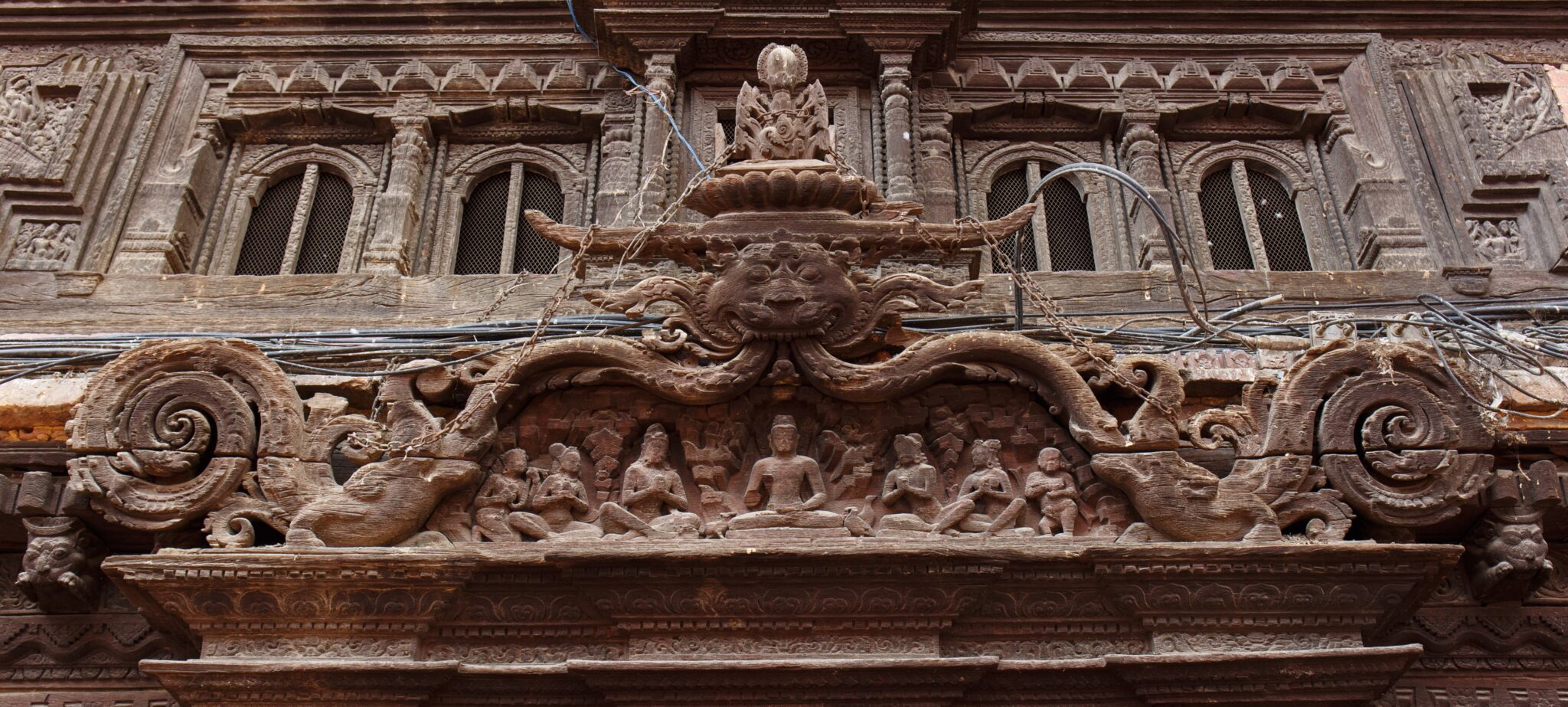
Torana of the Main Shrine of Yetakha Baha; Kathmandu, Nepal; 10–11th century; wood; total width approx. 8 ft. 5 in. (2.57 m); photograph by Sameer Tuladhar, 2021
Torana of the Main Shrine of Yetakha Baha; Kathmandu, Nepal; 10–11th century; wood; total width approx. 8 ft. 5 in. (2.57 m); photograph by Sameer Tuladhar, 2021
The unique wood carvings of the gate of the Yetakha monastery are among the oldest and finest in Nepal. The choice of the images is unusual for such gate decorations. Researcher Kashinath Tamot and art historian Ian Alsop examine this mysterious gateway, tracing the monks, priests, merchants, builders, and woodworkers who formed the monastery community.
Baha and bahi are institutions in Newar Buddhism that have their origins in Indian Buddhist monasteries (Skt. vihara). By the twelfth-thirteenth century, celibate monasticism had gradually ceased to be practiced in Nepal. Descendants of monks known as Shakya, a name which references their kinship with Shakyamuni Buddha’s clan and monastic affiliation, retained control of the former monasteries (Newar “baha” and “bahi”) as family property passed down through paternal descent. Along with Vajracharya Buddhist priests, they comprise the Newar Buddhist sangha. The bahas and bahis remain the centers of Newar Buddhist life today, and usually consist of an open courtyard with a stupa at the center and a large temple building on the side opposite to the entrance.
The kirtimukha is a symbolic element in South Asian art—a mask-like face of a fanged beast. Kirtimukhas are usually placed above other elements, such as upper portions of the carved portals, throne backs, or as a row adorning the upper portions of the painted walls.
In Indic mythology, a makara is a mythical crocodile-like creature that lives in rivers and lakes and is generally associated with water. In Himalayan art, certain deities are depicted as riding makaras. More commonly, makaras appear as decorative motifs on either side of gateways, or around the torana. In Newar art of the Kathmandu Valley they represent a rain cloud and appear as aquatic creatures with teeth and a curling elephant trunk-like snout.
The Newar People of the Kathmandu Valley of Nepal retain the unbroken traditions of Mahayana and Vajrayana Buddhism south of the Himalayas, preserving many ritual practices and Sanskrit-language texts that have been lost elsewhere. Celibate monasticism is no longer practiced among the Newars, but instead Buddhist ritualists are divided into two castes. One is the Shakyas, temple-priests who maintain ancient urban monasteries (Newar: bahas, bahis) as places of worship. The other is the Vajracharyas, tantric specialists who perform rituals at communal festivals and important life events. The Svayambhu Stupa is the most important ritual center for Newar Buddhists and the center of the Kathmandu Mandala. Today many Newars also practice Theravada and Tibetan Buddhism.
In Buddhism, the sangha refers to the community of religious practitioners. Buddhists consider the sangha one of the Three Jewels of their religion, along with the Buddha and the Dharma. There are many different branches of the sangha in different Buddhist traditions, including monks in monasteries, nuns in nunneries, and lay-practitioners. Traditionally, most Buddhist monks take vows of chastity, non-violence, and so on at ordination and live studying philosophy, meditating, and carrying out rituals on behalf of the community. In Newar Buddhism, the sangha is formed by household monks and their families. Boys from Vajracharya and Shakya families go through the symbolic rituals of ordination, becoming monks for four days.
Torana is a Sanskrit word that usually refers to a gateway, but in Nepalese usage it is generally used for the decorative upper panel framing the top of a doorway (or other portal like a window), that embellish the entrances to shrines, temples, and Buddhist monasteries. Toranas in Nepal are typically adorned with mythological creatures, such as snake spirit (naga), water monster (makara), and the “sky face ” (kirtimukha). A set of six ornaments commonly found on Tibetan toranas are: a mythical bird (Garuda) at top, holding the tails of a pair of coiling snake spirits (naga), water monsters (makara), a pair of leogryphs, ridden by youths, supported by a pair elephants at the bottom.
The most celebrated examples of woodworking in the Kathmandu Valley are the roof struts, almost always depicting curvaceous tree dryads (shalabhanjikas), that decorate and reinforce the roofs and the that guard and embellish the entrances to the main shrines of temples and Buddhist monasteries (bahals).
The main shrine of the spacious square (fig. 2) known as Yetakha Baha, not far from the royal palace of the city of Kathmandu, boasts stunning examples of these two important genres of Newar wood carving. The four carvings of lovely dryads entwined in trees mounted on the third floor and supporting the roof (fig. 3) are prime examples in the valleywide corpus of remarkable early struts. But the torana topping the gateway to the main shrine is particularly important for its great age, wonderfully elegant composition, and the rarity of its design.
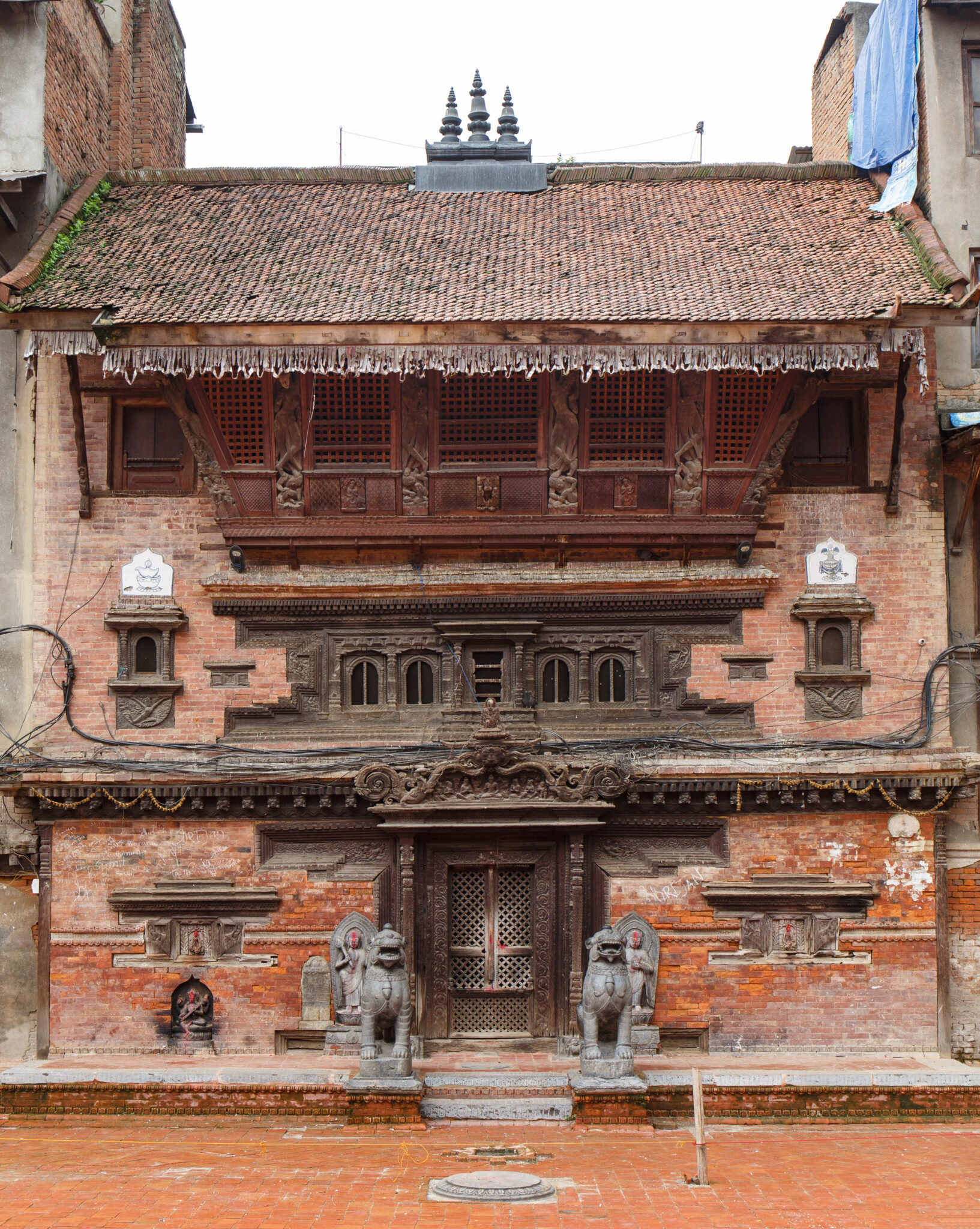
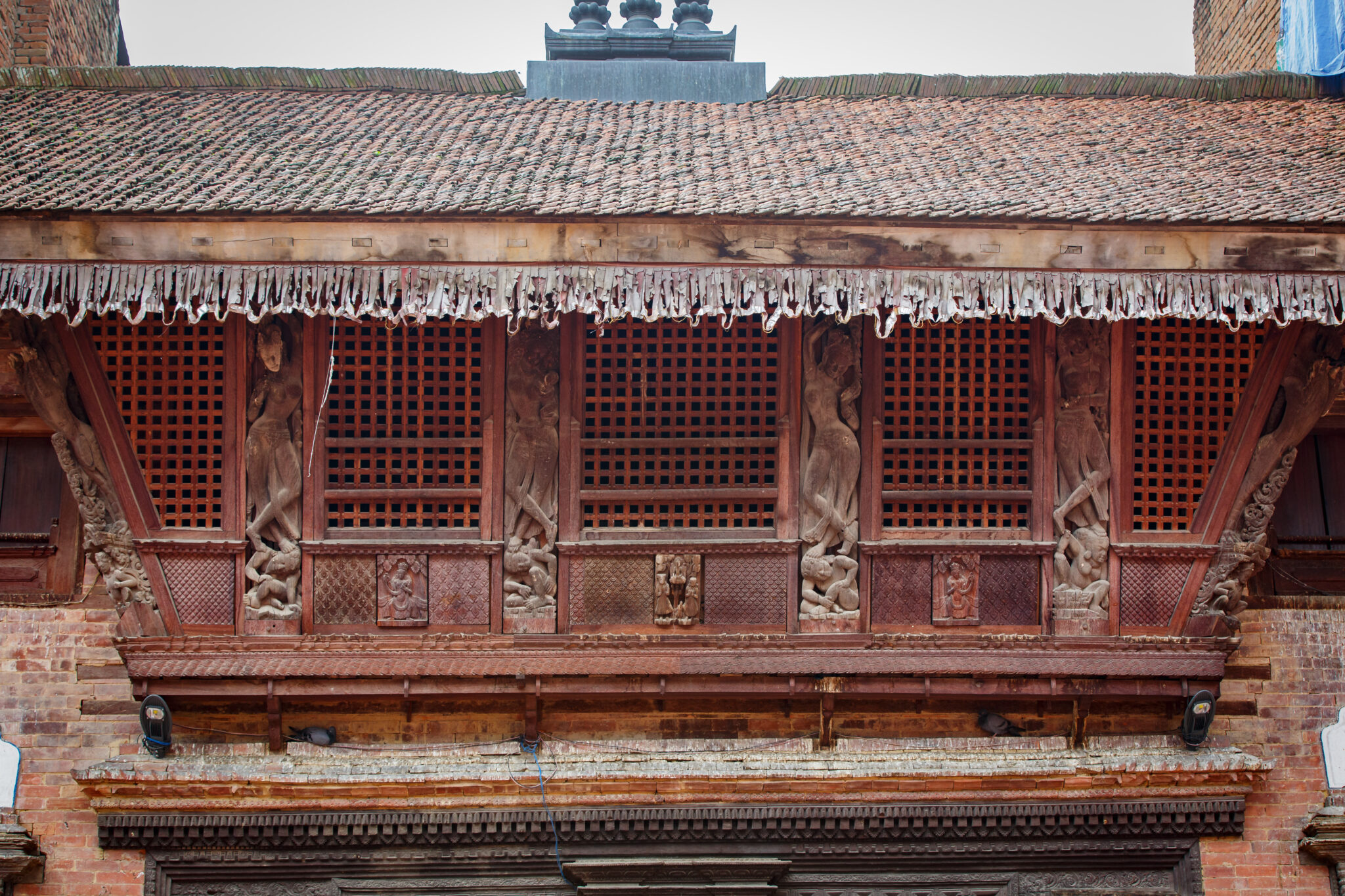
Torana is a Sanskrit word usually referring to the entire gateway; in Nepalese usage, however, it is primarily reserved for the upper panel. The torana of Yetakha Baha is the oldest such wooden architectural element known in the Kathmandu Valley, radiocarbon-dated between 900 and 1030 CE. It takes the form of an elongated horizontal, unlike most other toranas gracing Nepalese Hindu temples and Buddhist bahals in the valley, which are semicircular, such as the spectacular one embellishing the entrance to Chusya Baha in Kathmandu (fig. 4).

Torana over the Main Entrance of Chusya Baha; Kathmandu, Nepal; 1663; wood; photograph by Sameer Tuladhar, 2021
The Yetakaha Baha torana is also unique for its composition, which features the in the center preaching to an assembly of two men and two women (or divine beings), all seated with their legs loosely crossed and their hands held together in the gesture of attentive adoration and respect (fig. 5). The Buddha is seated serenely in full lotus position, his left hand in his lap and his right hand raised before his chest in the gesture of teaching. His hair is adorned, piled up in a chignon fronted by a crown ornament, like that of a .
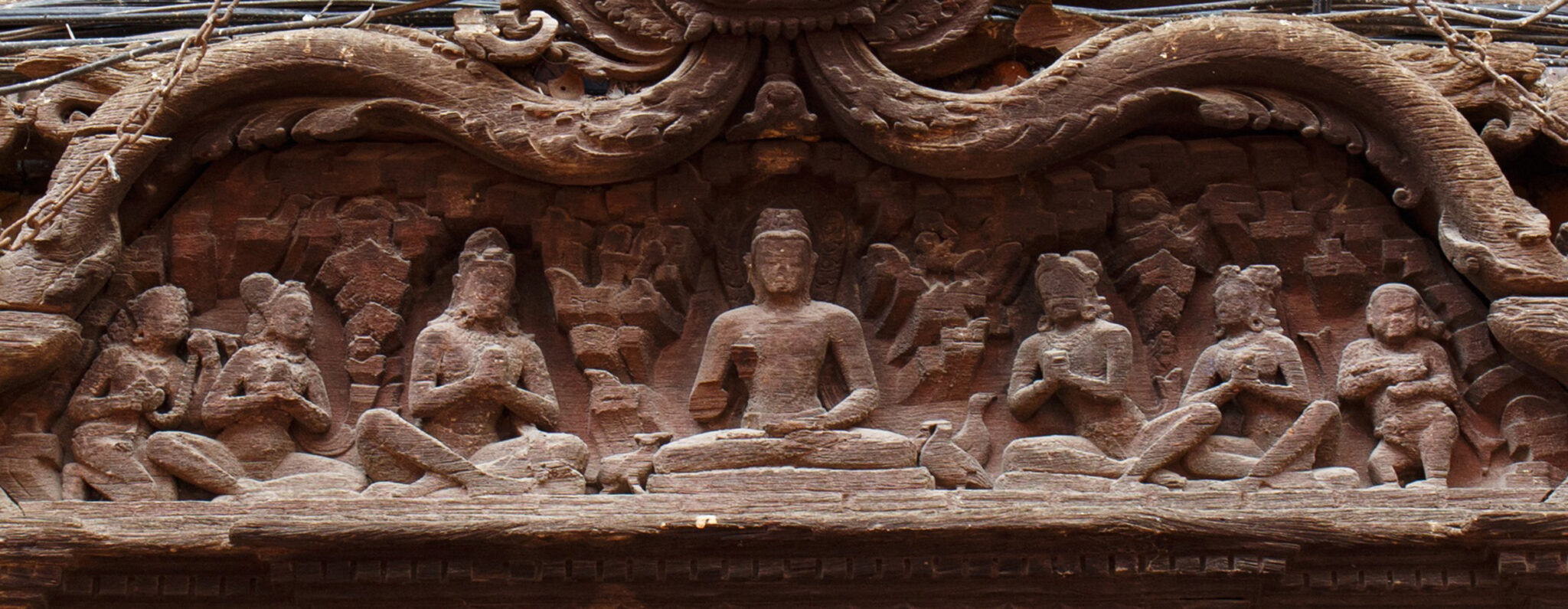
Detail of the Torana of the Main Shrine of Yetakha Baha; Kathmandu, Nepal; photograph by Sameer Tuladhar, 2021
This group is augmented at either end by smaller attendant figures: on the left, a kneeling woman or goddess holding a garland in offering, and on the right, a small, rotund dwarflike male looking out from the scene and holding an offering of some kind in his crossed arms. An array of geometrically defined rocks forms the background to this peaceful scene of religious discourse, each figure set into a recess as if in caves in a vertical face. At the Buddha’s knees are a deer and a pair of birds, while other creatures—a monkey, a child, and a pair of lions—cavort or peer out from the rocks above. This rocky scene evoking the mountains that dominate the Kathmandu Valley skyline on a clear day is the only torana so far known “showing a Himalayan scene.”
The entire scene is surrounded by a dynamic frame of three mythological creatures: two —aquatic-footed creatures with an elephant-like trunk and extravagant curling tails—to left and right and the awesome grimacing leonine face of a chepu or above center. These three familiar figures in Newar art and design are joined by the sinuous coils of serpents—resembling tendrils of an enormous vine—which emerge from the chepu’s mouth and disappear into the maws of the makaras on either side. The interplay of the peaceful contemplative scene of the Buddha and his acolytes surrounded by the energy of these creatures produces an unrivaled tour de force of Newar wood carving.
Considering the great age of the wonderful torana, surprisingly little inscriptional or documented evidence of the place name Yetakha can be found prior to the sixteenth century, and all of the on-site inscriptions belong to the eighteenth and nineteenth centuries. A nineteenth-century inscription gives the name of the bahal as Bhaskara Malla Mahavihara, “the great of (King) Bhaskara Malla,” a Kathmandu king who reigned from 1700 to 1722.
Some local legends attribute the bahal to an earlier king, Bhaskara Deva of the eleventh century, which has led to the name Sri Bhaskarakirti Mahavihara (the monastery of the glory of [king] Bhaskara). The age of the wooden torana and the struts above it lend some credence to this earlier attribution, and largely because of this evidence several scholars have endorsed the connection with the earlier king. An oral tradition holds that the queen of the earlier Bhaskara Deva (r. ca. 1045–1048) founded the bahal sometime after the nearby Itum Baha was founded. These two bahals have long been linked: Itum Baha is one of the most important of the main monasteries of Kathmandu, and Yetakha Baha is usually counted as a branch of Itum Baha, a relationship often confirmed by Itum Baha residents, but disputed by the residents of Yetakha.
The community in which this remarkable carving is found is as unusual as the work itself. The residents of Yetakha Baha are from the Newar group known as the Udas or Uray. The Udas community in Kathmandu can be traced back to quite ancient times. It seems that eventually they moved into the areas of medieval Kathmandu, and some came to the locality later called Etakha or Yetakha; it is possible that the Udas adopted at the time of these migrations.
The Udas community in Kathmandu is large and influential, comprising various groups of families who traditionally followed a specific trade or practiced a craft. The largest single group is the Tuladhar (the holders of the scales), who are traditionally businessmen and historically have played an important role in trade with Tibet. It is possible that the original founder of the shrine now known as Yetakha Baha was a wealthy Lhasa trader, a devout Buddhist who commissioned the torana with its remarkable Himalayan theme, perhaps partially to remind him of his second home in the Land of Snows. Dhanasimha Tamrakar, the Udas founder of a small subsidiary nineteenth-century shrine in Yetakha, was known as a merchant who prospered in the Tibet trade. Most of the other Udas groups are artisans, including the Tamrakar, workers in copper, Kansakar, workers in bronze, and, notably, the Sthapit, builders and wood-carvers. It is likely that the Yetakha torana was made by a Sthapit wood-carver.
The name Bhaskara Malla mahavihara, which refers to Yetakha Bahal, is found in the nineteenth-century dedicatory inscription commemorating the establishment of Dhanasimha Tamrakar’s private shrine, which has since become known as Dhanasimha Baha. This shows the relative looseness of the term baha, which normally is associated with the viharas (monasteries) but can also mean “any courtyard having a Buddhist shrine.” The term bahal, related to the vihara, is normally reserved for communities of or residents, initiated Newar Buddhists who are considered the descendants of the original monks and priests of an earlier time. Although the Shakyas and Vajracharyas are now all married householders, they still are initiated in their youth into the Buddhist monkhood or priesthood, in a ritual that is usually followed by a brief period of symbolic monkhood, and their community is still known as a , the community of monks that is one of the traditional three pillars of Buddhism—Buddha, , and sangha (the Buddha, his teachings, and the community of monks).
The Udas community of Yetakha Baha cannot be considered a sangha because its members, though considered the respected laymen of the traditional Buddhist hierarchy, do not go through the ritual initiation into the monkhood, which is experienced by all young Shakya and Vajracharya men. Rather, the community of Yetakha Baha is defined by membership in a guthi, the main Newar social grouping; the Yetakha guthi is dedicated to the recitation of the Namasamgiti, an essential Vajrayana Buddhist text. Up until recent times, the daily worship of the central of the Yetakha Baha shrine was performed by a Vajracharya priest from nearby Itum Baha, but after a recent dispute, since the early 2000s the daily worship has been taken up by a group of Udas elders from the Yetakha community itself.
The renowned business skills of the Udas trading families were matched in the arts by the skills of the Sthapits, wood-carvers and architects. Likely from ancient times, these master wood-carvers, like the traders, often traveled north to pursue their craft, most spectacularly evidenced in the wonderful carvings of the Lhasa Jokhang. Their skills are on display elsewhere in the Yetakha neighborhood as well, as in the tour de force known as the Window without an Equal (Deshay Maru Jhya) in a house on a street outside the Yetakha square (fig. 6). Members of these two groups of the Udas community collaborated, to paraphrase Hemraj Shakya, as the artist who created . . . and the donor who financed the torana and the struts of Yetakha, at a time long ago, when it was not yet known as Yetakha Baha, but already represented the wealth and skills of the Newar Buddhist lay community of traders and artisans.
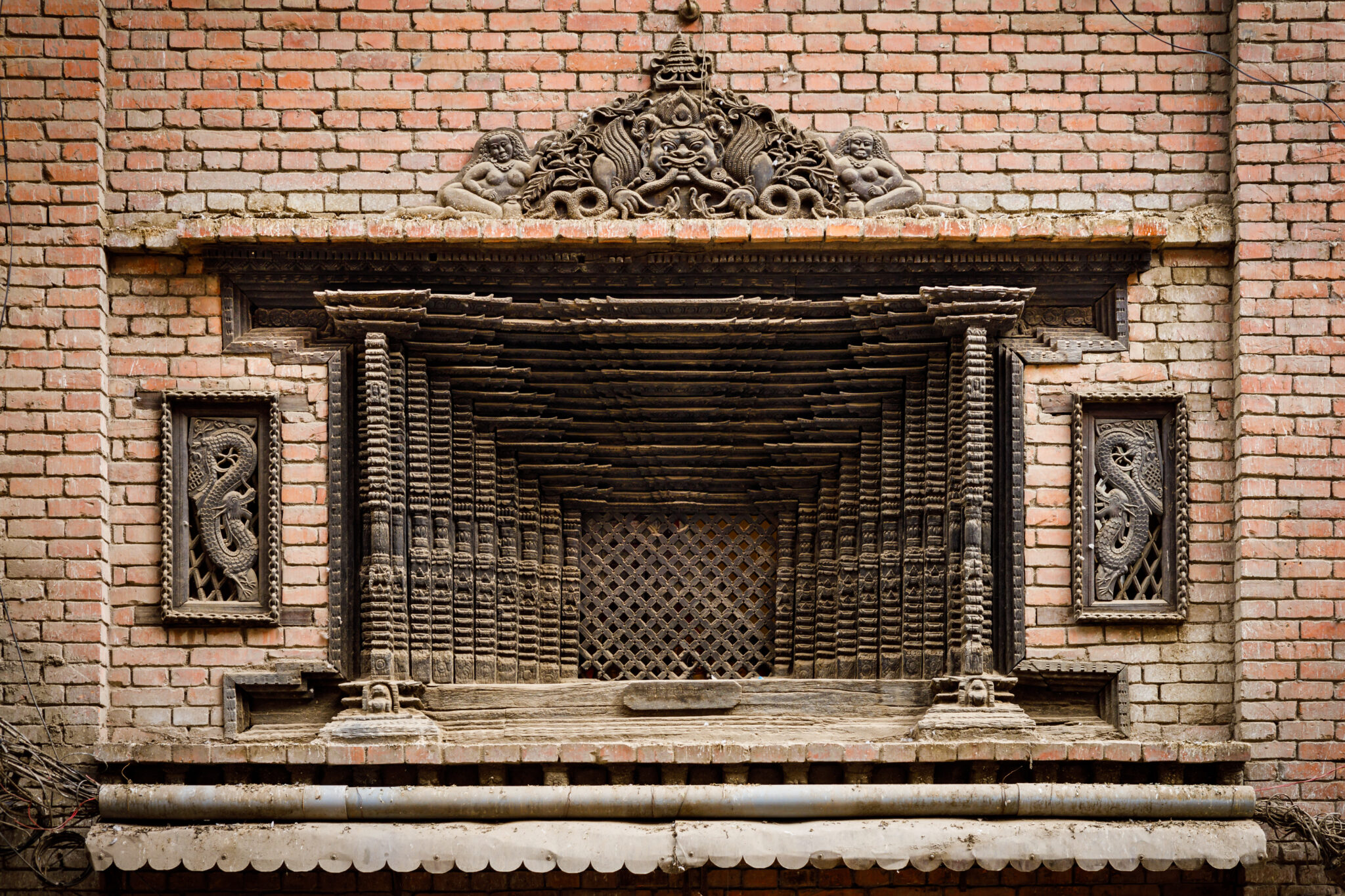
Deshay Maru Jhya (Window without an Equal); Yetakha tol; Kathmandu, Nepal; ca. 18th century; wood; photograph by Sameer Tuladhar, 2021
Mary Shepherd Slusser and Paul Jett, The Antiquity of Nepalese Wood Carving: A Reassessment (Seattle: University of Washington Press, 2010), 128, examines the “woman and tree” motif, and in 66ff., figs. 64–69, dates the Yetakha Baha struts.
The term tympanum, a word derived from Greek or Latin, refers specifically to the decorative element above the doorway, and is used by Niels Gutschow, Architecture of the Newars: A History of Building Typologies and Details in Nepal (Chicago: Serindia, 2011), 246, and Gautama V. Vajracharya, Nepalese Seasons: Rain and Ritual, Exhibition catalog (New York: Rubin Museum of Art, 2016), https://issuu.com/rmanyc/docs/nepalase_seasons_-_combo-_96_ppi, 57, while Mary Shepherd Slusser and Paul Jett, The Antiquity of Nepalese Wood Carving: A Reassessment (Seattle: University of Washington Press, 2010), 207, prefers the term torana, used in Nepal.
Mary Shepherd Slusser and Paul Jett, The Antiquity of Nepalese Wood Carving: A Reassessment (Seattle: University of Washington Press, 2010), 208, fig. 194.
Hemraj Shakya, Śrī Bhāskarkīrti mahāvihāra Yeṭakhābāhāḥ chagu adhyayana, vol. 21 (Kathmandu: Yeṭakhābāhāḥ Ᾱrya nāmasaṃgīti guṭhī, NS 1099 Maṃśira 21 (December 6, 1978), 1978), 15.
Mary Shepherd Slusser and Paul Jett examine the history and meaning of this motif; Mary Shepherd Slusser and Paul Jett, The Antiquity of Nepalese Wood Carving: A Reassessment (Seattle: University of Washington Press, 2010), 212ff., and Gautama V. Vajracharya, “Kirtimukha, The Serpentine Motif, and Garuda: The Story of a Lion That Turned into a Big Bird,” Artibus Asiae 74, no. 2 (2014): 311ff., fig. 22.
The oldest mention of Yetakha is a legal document from 1573; Mahesraj Pant, “Nevārarājyakā Kānūnī likhatamā sthāpita ra bārāhi,” Sthāpita Khalah (Souvenir) 4, no. 4 (NS 1133/VS 2070) (2013): 64, 67.
Hemraj Shakya, Śrī Bhāskarkīrti mahāvihāra Yeṭakhābāhāḥ chagu adhyayana, vol. 21 (Kathmandu: Yeṭakhābāhāḥ Ᾱrya nāmasaṃgīti guṭhī, NS 1099 Maṃśira 21 (December 6, 1978), 1978), 19ff.
Hemraj Shakya, Śrī Bhāskarkīrti mahāvihāra Yeṭakhābāhāḥ chagu adhyayana, vol. 21 (Kathmandu: Yeṭakhābāhāḥ Ᾱrya nāmasaṃgīti guṭhī, NS 1099 Maṃśira 21 (December 6, 1978), 1978), 20–23; see also John K. Locke, Buddhist Monasteries of Nepal: A Survey of the Bāhās and Bahīs of the Kathmandu Valley (Kathmandu: Sahayogi Prakashan, 1985), 293; Mary Shepherd Slusser and Paul Jett, The Antiquity of Nepalese Wood Carving: A Reassessment (Seattle: University of Washington Press, 2010), 66.
Hemraj Shakya, Śrī Bhāskarkīrti mahāvihāra Yeṭakhābāhāḥ chagu adhyayana, vol. 21 (Kathmandu: Yeṭakhābāhāḥ Ᾱrya nāmasaṃgīti guṭhī, NS 1099 Maṃśira 21 (December 6, 1978), 1978), 20–23.
John K. Locke, Buddhist Monasteries of Nepal: A Survey of the Bāhās and Bahīs of the Kathmandu Valley (Kathmandu: Sahayogi Prakashan, 1985), 293.
The Udas in Kathmandu are overwhelmingly Buddhist, while the equivalent group in Patan are Hindu.
The full name is Manjushrinamasangiti (The Litany of the Names of Manjushri), a foundational Buddhist tantra.
Hemraj Shakya, Śrī Bhāskarkīrti mahāvihāra Yeṭakhābāhāḥ chagu adhyayana, vol. 21 (Kathmandu: Yeṭakhābāhāḥ Ᾱrya nāmasaṃgīti guṭhī, NS 1099 Maṃśira 21 (December 6, 1978), 1978), 15.
Gutschow, Niels. 2011. Architecture of the Newars: A History of Building Typologies and Details in Nepal, esp. 244–47. Chicago: Serindia.
Slusser, Mary Shepherd, with Paul Jett. 2010. The Antiquity of Nepalese Wood Carving: A Reassessment, esp. 66–78, 207–26. Seattle: University of Washington Press.
Vajracharya, Gautama V. 2016. Nepalese Seasons: Rain and Ritual. Exhibition Catalog. New York: Rubin Museum of Art. https://issuu.com/rmanyc/docs/nepalase_seasons_-_combo-_96_ppi.
Kashinath Tamot and Ian Alsop, “Torana of the Main Shrine at Yetakha Baha: A Marvel of Newar Woodworking,” Project Himalayan Art, Rubin Museum of Art, 2023, http://rubinmuseum.org/projecthimalayanart/essays/torana-of-the-main-shrine-at-yetakha-baha.
Lorem ipsum dolor sit amet consectetur adipisicing elit. Cum nihil placeat pariatur deserunt eius ullam incidunt maxime sunt ipsam. Ipsa, provident, laudantium, rem assumenda laboriosam veniam autem voluptas sint officia distinctio enim aut explicabo fuga animi voluptatum earum recusandae excepturi atque dignissimos iste? Exercitationem, praesentium eum. Harum ut maiores expedita exercitationem perspiciatis soluta aperiam dolores natus unde, sequi vitae debitis ex aliquam quas eum reprehenderit esse. Cumque amet et earum necessitatibus, repellendus ullam ducimus corporis architecto culpa placeat eum odit cum iure illo vitae rerum! Ullam et suscipit culpa? Eos voluptatum laudantium iste vero impedit adipisci maxime magni natus voluptatibus.
Get the latest news and stories from the Rubin, plus occasional information on how to support our work.